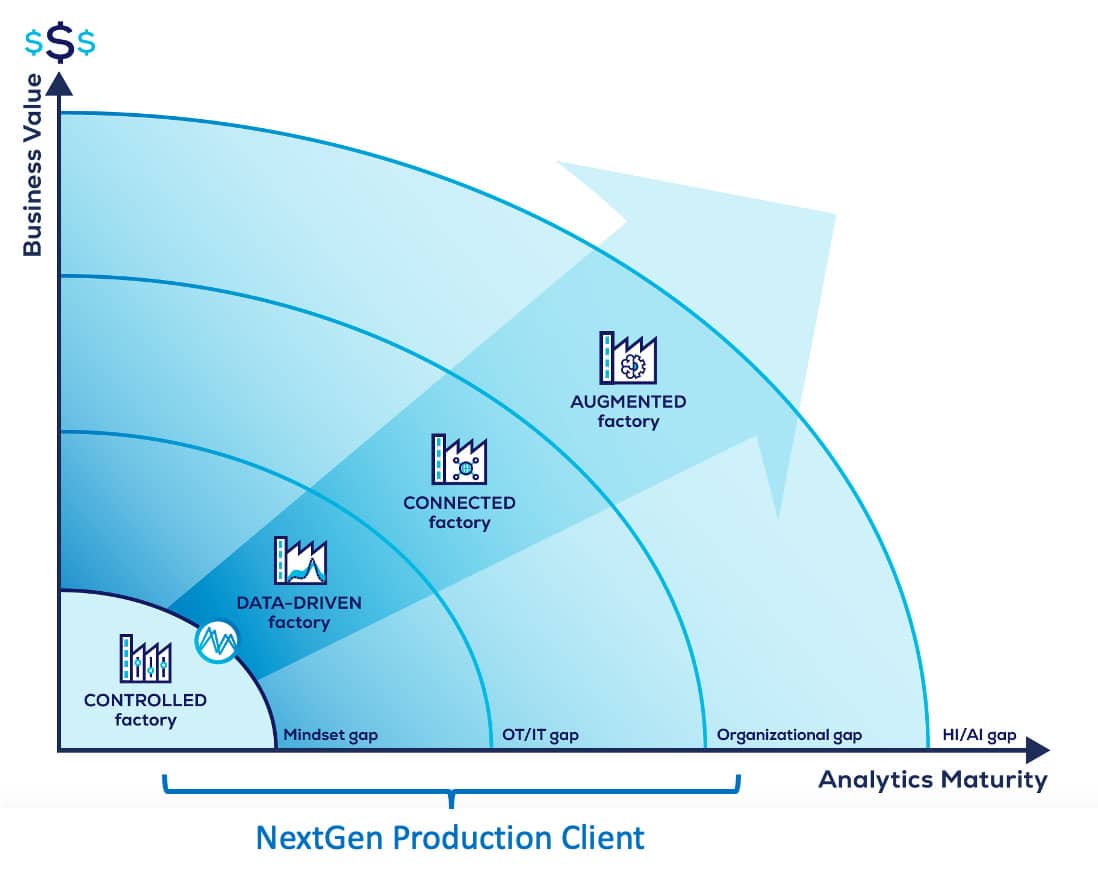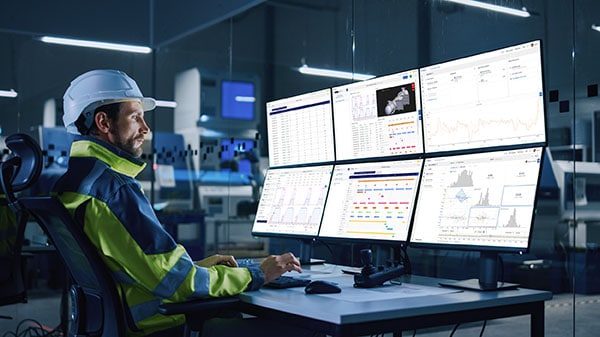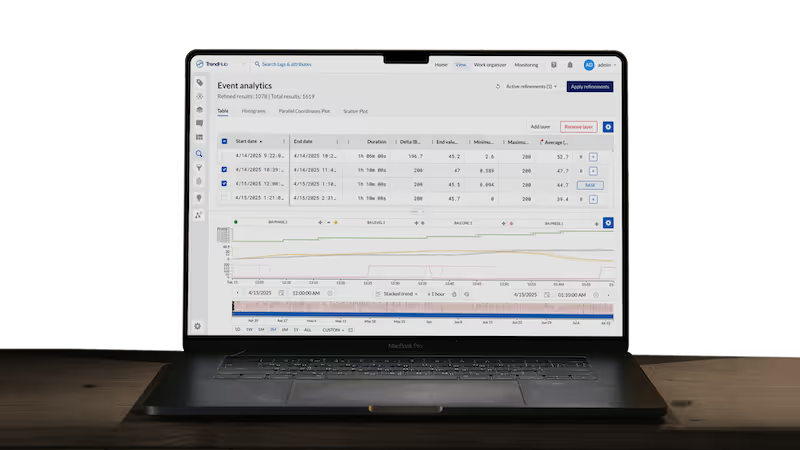Why We Built the Next Generation Production Client
From trend viewing to prescriptive analytics, TrendMiner supports you throughout your digitalization journey
TrendMiner already had a solution that provided self-service analytics to process engineers.
Why, then, did we need to build a next generation production client?
In short, organizations have changed their expectations. Engineers no longer are satisfied looking at a trend client for answers to process behavior. They need to be able to analyze, monitor, and predict that behavior to meet business objectives.
A magazine editor recently asked us why TrendMiner 2022.R1 is a next-generation production client. Don’t we already have a solution that was made for any engineer, he asked? We told our editor friend that the software had to adapt. Rather than put the information only in the hands of the analytical-savvy engineer, the new TrendMiner release offers insights to engineers who are working at any analytics maturity level.
The editor quickly understood that 2022.R1 is a new solution. TrendMiner still is a self-service analytics platform, but it’s capable of much more. Nick Van Damme, Director of Products, said this about the new release:
“Ease-of-use is crucial for the successful democratization of analytics. Over the years, we have received many improvement ideas and feature requests from our users. The new trend analysis client puts users at the center, so they can analyze their production processes and improve operational performance faster than ever. That makes their company more agile to address fast-changing market demands.”
Here are some more details about what makes this version of TrendMiner such a big deal.
TrendMiner NextGen: Insights for Any Analytics Maturity
Companies already were moving to more data-driven workflows before the COVID-19 pandemic. But the global health crisis helped speed up adoption of putting data in the hands of everyone. With more people working from home, for example, fewer people were on the floor in manufacturing plants. Everyone who had in interest in process behavior—whether they were in the factory or not—wanted information quickly with enough time to act.
It wasn’t long ago when companies first experimented with time-series data to see what benefits it might have for optimizing manufacturing processes. Today, organizations empower their process engineers with analytics solutions. They are racing to adopt the “new normal” and put process analytics in the hands of every engineer.

For our customers, that means making the data available to engineers with different analytical skill sets. Some engineers in the control room might want a quick visualization of the processes to ensure they are behaving optimally. Others will use the software’s capability of performing root-cause analysis to determine why quality is degraded for certain batches. Finally, another group of engineers might be interested in the data science features: Python notebooks for evaluating tough cases and the ability to apply machine learning techniques.
Engineers exploring time-series data can use TrendMiner to apply all four types of analytics: descriptive, diagnostic, predictive, and prescriptive.
TrendMiner NextGen: User-Centric Analytics
There’s no room for a production client that engineers struggle to use. As manufacturers and their engineers increase their digital maturity level, they will need a scalable next generation solution capable of growing with them.
Since its inception, TrendMiner has rolled out to thousands of users across the world. We asked them to provide feedback and tell us what they needed in a next generation production client. Matching their digital maturity needs topped the list. Second? A friendly, easy-to-navigate user interface for a seamless user experience.
Engineers will find that trend analysis can be easy, and they no longer must struggle with unruly spreadsheets to evaluate process behavior. The software offers quick and fast insights for time-series data that can bring value to any underlying infrastructure. Furthermore, its ContextHub offers contextual analysis next to time-series analysis. Engineers can take operational events into consideration, such as typical cycle time, downtime, or the mean time between defects. The contextual information helps engineers identify the ideal operating conditions for processes and allows them to create a strong golden fingerprint for optimal production.

Searching, coloring, switching, and comparing trend views is the basis for a quick production performance overview. New and enhanced features (such as simplified view saving, grouping, and auto-scaling of multiple tags, scrolling & panning of axis, more detailed scatterplots colored by time, and multiple calculations on search results) give users full flexibility and agility to explore their data visually.
Find out more ways process experts can use TrendMiner NextGen
- Create monitors and soft sensors in a unified monitoring center. The center combines the monitor and inbox features and fosters easier access to historical results and their related searches.
- View trend analysis visualizations, such as stacked trends, histograms, and scatterplots, in personalized dashboards.
- Develop more complete dashboards with contextual information from third-party applications, including Gantt charts.
- Compare process events easily by visualizing multiple content items at once, such as batch run data, in trend views.
- Enrich dashboards with external content by embedding images, videos, or other materials from sources such as PowerBI, Tableau, PI Vision, P&IDs, and 3D CAD models.
TrendMiner NextGen: Security by Design
Last, but certainly not least, one of our most important improvements in the latest release is not as obvious on the surface. The new version of TrendMiner is built on an industry-standard, scalable deployment architecture that is offers greater flexibility as well as increased security.

Organizations have changed their technical and deployment requirements drastically. Companies have begun storing their data for analysis in large cloud-based platforms (such as AWS or Azure) instead of traditional historians. Although these offer robust storage solutions, they offer little in the way of data exploration techniques. Furthermore, they can expose data to risks as it enters the global internet.
The latest version of TrendMiner offers a secure by default design. This means it uses the best security practices available without requiring configuration. In fact, with secure by design, users do not even know the features are there.
“Global operating manufacturing companies are wary about cyberattacks and have application vulnerabilities and security high on their IT agenda,” said Jan de Dobbeleer, CTO at TrendMiner. “Secure by design means that software products and capabilities have been designed to be foundationally secure, and that is what we also have done for TrendMiner. All future releases of TrendMiner will add additional improvements to ensure that any installation of TrendMiner is secure by default: enforcing security best practices without needing additional configuration.”
In addition to including architecture designed to withstand cyberattacks, TrendMiner Next Gen offers greater local user management control, stronger passwords policies, SSL/TSL by default, and integration with existing security solutions.
TrendMiner NextGen: Software in Use
A chemical company had difficulty controlling a continuous process in the column for producing acetone cyanohydrin. The process also tended to swing between operating points. Trimming the control based, on-lab analysis led to energy and production loss. The company spent months trying to establish a reliable data model to solve the problem.
Engineers used TrendMiner to analyze the continuing process. They performed a global search to determine a set of influencing parameters that lead to creating and validating a multivariate model.
The company then used that model to create a golden fingerprint of the process. Engineers set up dashboards within TrendMiner to monitor the process and look for deviations in the influencing parameters that might cause it to swing to another operating point. When the process deviated from its golden fingerprint, TrendMiner set off alerts to let key stakeholders know there is a problem with enough time to intervene and take corrective action.
In the future, process engineers can identify patterns of behavior over time. They can use these patterns to predict when the process will fall outside its golden fingerprint and adjust conditions to produce an ideal batch. Engineers also can prescribe machine learning techniques to ensure the process adheres to influence parameters that match its ideal operating conditions.
By using TrendMiner to improve operational performance, the company saw its yield increase by 1%. It also realized an energy consumption reduction for the purification cycle. The result? A savings of approximately €2 million per year.
TrendMiner NextGen: Ready to Optimize Production
Are you ready to make the most of your time-series data?
Watch TrendMiner’s Nick Van Damme and Michael Chang demonstrate the value of its next generation production client. Learn how the software can be used to analyze, monitor, and predict process events. Engineers will find they are empowered to improve operational performance while increasing sustainability goals and improving the bottom line.
See it, use it, love it. Learn how TrendMiner’s next generation production client will bring value to your organization, regardless of its analytics maturity.










